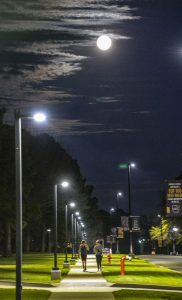A Worm Moon And The Equinox
by admin | March 22, 2019 8:07 am
The vernal equinox arrived at 5:58 p.m. on Wednesday, marking the official arrival of spring. With it came the third and final supermoon of the year, all of which appeared in the first three months of 2019. The worm moon — named because the ground begin
 s to warm and earthworms rise — wasn’t as spectacular as January’s blood moon, which was accompanied by a lunar eclipse and made for quite a sight. I went out nevertheless after completing my shift at the university library and shot some photos before heading home.
s to warm and earthworms rise — wasn’t as spectacular as January’s blood moon, which was accompanied by a lunar eclipse and made for quite a sight. I went out nevertheless after completing my shift at the university library and shot some photos before heading home.
An equinox means the sun is shining directly above the equator, and day and night are of approximately equal length. There are two reasons day and night are not exactly equal, according to a Washington Post story. First, there is the refraction of the sun’s light through the atmosphere, causing the sun to appear a tad higher than it is in actuality. Second, we measure sunrise from when the first edge of the sun appears on the horizon, and sunset when the upper edge sinks below, thus making daytime slight longer.
This is the first time since 2000 for a “super worm equinox moon,” which means a full moon occurs on the same day as the vernal equinox. It was lovely, especially as wispy clouds slid across, briefly obscuring slivers of the moon, then dancing away. I lingered on campus, taking photos with a lens far too short to do justice to an object that is 238,900 miles away.
|———|
Winter hung around longer than usual this season, but the signs of spring are prevalent. Pollen is beginning to coat everything as trees bud out. It rains down a yellow powder in phases from the various trees, the most prodigious offender being pine trees.
I ran into a friend in Walmart and we talked in the coffee aisle about starting the spring cleaning chores — power washing the house, deck, etc. He said he has already started washing the house exterior. I don’t intend to begin until I am certain the pollen has finished, though my trigger finger longs to power up the pressure washer.
Out in the parking lot, grackles hopped about, cawing and looking for dropped french fries and other food items. At least they sound and act like grackles. Maybe they’re crows. Regardless, Walmart has become a popular hangout for these golden-eyed scavengers, especially as the weather warms.
|———|
Our azaleas are beginn [1]ing to blossom and will reach their peak in a few weeks. This time of year (except for the coating of pollen on everything), our yard truly looks like a garden park with nearly the entire space is covered in azaleas. I was worried a recent hard freeze might have burned the buds, but these shrubs are mature and seem to have come through just fine.
[1]ing to blossom and will reach their peak in a few weeks. This time of year (except for the coating of pollen on everything), our yard truly looks like a garden park with nearly the entire space is covered in azaleas. I was worried a recent hard freeze might have burned the buds, but these shrubs are mature and seem to have come through just fine.
A trip to the Mize Azalea Garden on the campus of SFA in Nacogdoches might be in store. The 50-acre garden features more than 6,500 azaleas, as well as many other wonderful trees and shrubs. It is a lovely place to spend an afternoon.
Up the hill from our home, a neighbor’s redbud tree blooms. Walking by it prompted me to search the web for the reason a tree with obviously violet flowers acquired the name “redbud.” Normally, Google provides a satisfying answer, but not in this case. Certainly I wasn’t the first person to pose the question, but the only answer I found — and it is pure supposition — is that the tree was named by a colorblind man. Nevertheless, the redbud tree remains one of my favorite springtime trees.
I did learn something. The tree is also called the Judas tree, the legend being that Jesus’ traitor hanged himself on a redbud tree. I would rather call it a redbud tree.
|———|
Bluebonnets will arrive in Central and West Texas primarily in April, which might spur yet another road trip, perhaps to Brenham. This season’s crop promises to be spectacular, thanks to abundant fall rains.
Certainly, we are blessed to live among such beauty. Take time to appreciate it. Soon it will be summer and sweat.
- [Image]: http://garyborders.com/pages/a-worm-moon-and-the-equinox/spring-moon/
Source URL: https://garyborders.com/pages/a-worm-moon-and-the-equinox/